Capstone Project: Change Proposal on Pressure Ulcer Management
VerifiedAdded on 2022/09/26
|9
|2381
|22
Project
AI Summary
This capstone project presents a comprehensive change proposal aimed at addressing the critical issue of pressure ulcers, or hospital-acquired pressure injuries (HAPI), within a 438-bed hospital. The project begins with a clear problem statement, highlighting the significant impact of pressure ulcers on patient morbidity, mortality, treatment costs, and reimbursement. The proposal's purpose is to reduce and effectively manage HAPI, raising awareness among healthcare professionals. A PICOT statement guides the research, focusing on interventions like good skincare versus pressure-reducing mattresses. The project employs a systematic literature review, utilizing databases like PubMed and Google Scholar, and the Havelock’s model of change is proposed for implementation. The proposed implementation includes staff training, soft dressings, pressure-release mattresses, and regular skin treatments, with barriers such as workload and inadequate training addressed through strategies such as continual monitoring and leadership support. The project concludes with a summary of the key findings, emphasizing the importance of the change proposal in enhancing patient outcomes and reducing the risks associated with pressure ulcers. The project also includes a literature review and PICOT statement.
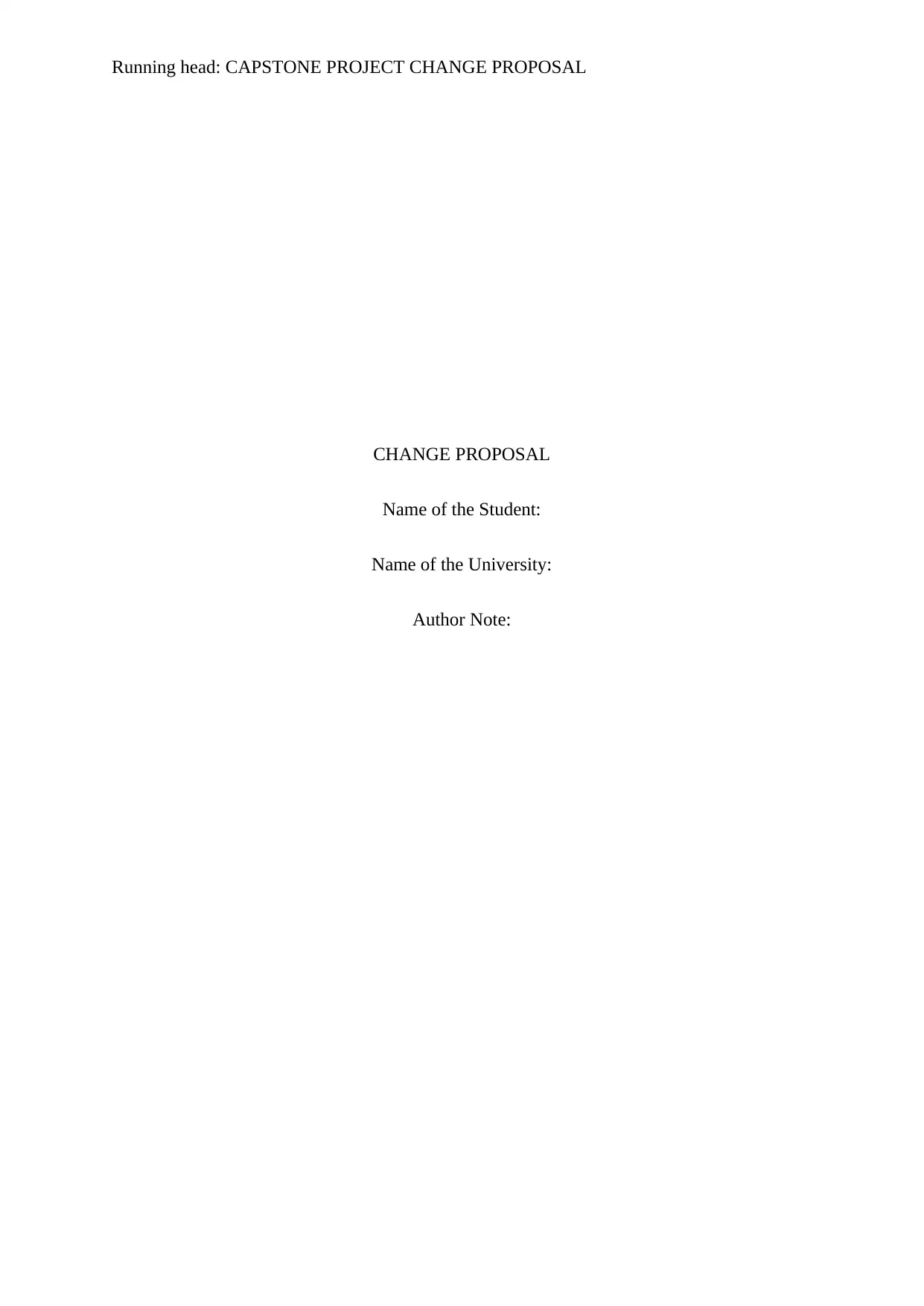
Running head: CAPSTONE PROJECT CHANGE PROPOSAL
CHANGE PROPOSAL
Name of the Student:
Name of the University:
Author Note:
CHANGE PROPOSAL
Name of the Student:
Name of the University:
Author Note:
Paraphrase This Document
Need a fresh take? Get an instant paraphrase of this document with our AI Paraphraser
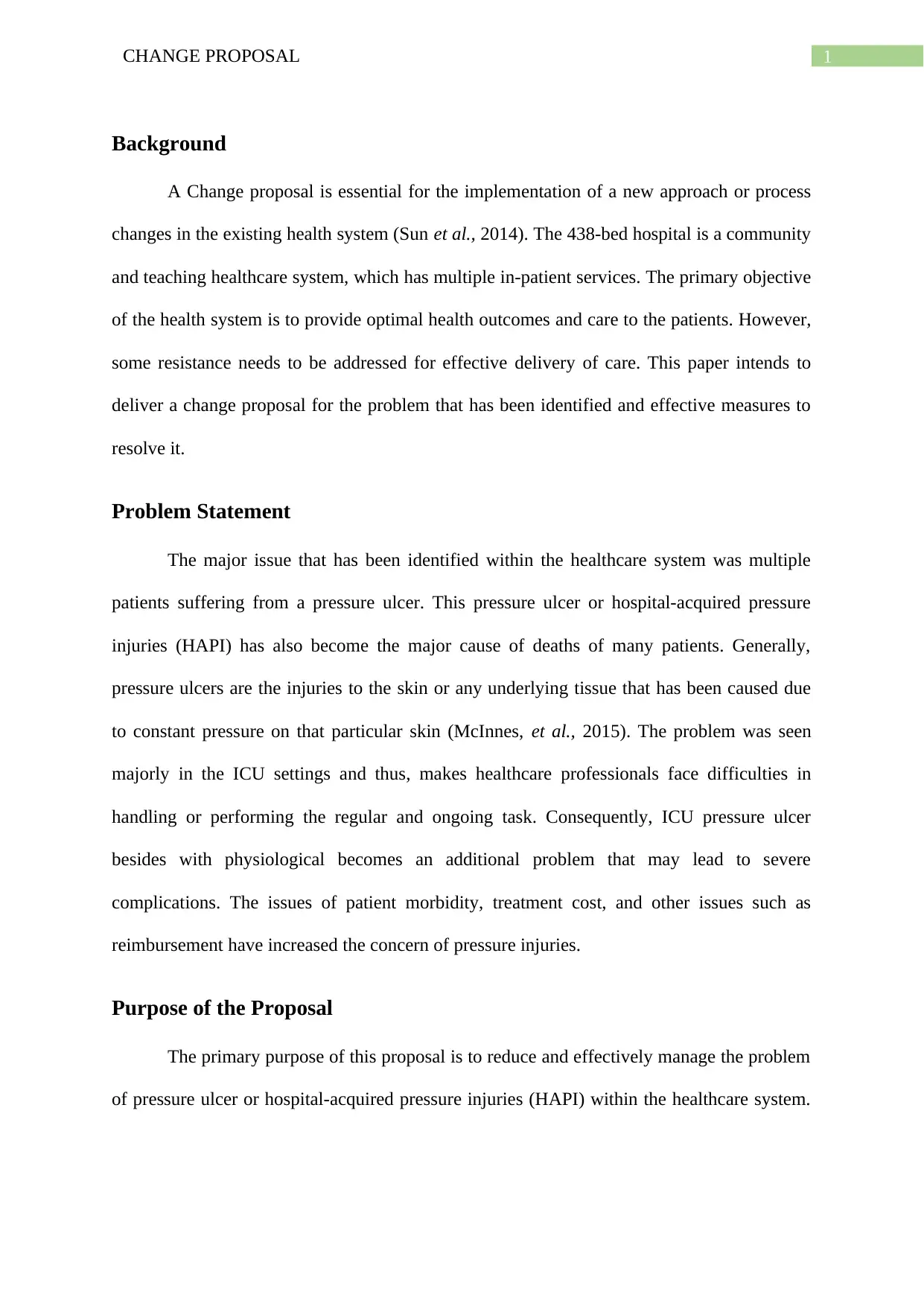
1CHANGE PROPOSAL
Background
A Change proposal is essential for the implementation of a new approach or process
changes in the existing health system (Sun et al., 2014). The 438-bed hospital is a community
and teaching healthcare system, which has multiple in-patient services. The primary objective
of the health system is to provide optimal health outcomes and care to the patients. However,
some resistance needs to be addressed for effective delivery of care. This paper intends to
deliver a change proposal for the problem that has been identified and effective measures to
resolve it.
Problem Statement
The major issue that has been identified within the healthcare system was multiple
patients suffering from a pressure ulcer. This pressure ulcer or hospital-acquired pressure
injuries (HAPI) has also become the major cause of deaths of many patients. Generally,
pressure ulcers are the injuries to the skin or any underlying tissue that has been caused due
to constant pressure on that particular skin (McInnes, et al., 2015). The problem was seen
majorly in the ICU settings and thus, makes healthcare professionals face difficulties in
handling or performing the regular and ongoing task. Consequently, ICU pressure ulcer
besides with physiological becomes an additional problem that may lead to severe
complications. The issues of patient morbidity, treatment cost, and other issues such as
reimbursement have increased the concern of pressure injuries.
Purpose of the Proposal
The primary purpose of this proposal is to reduce and effectively manage the problem
of pressure ulcer or hospital-acquired pressure injuries (HAPI) within the healthcare system.
Background
A Change proposal is essential for the implementation of a new approach or process
changes in the existing health system (Sun et al., 2014). The 438-bed hospital is a community
and teaching healthcare system, which has multiple in-patient services. The primary objective
of the health system is to provide optimal health outcomes and care to the patients. However,
some resistance needs to be addressed for effective delivery of care. This paper intends to
deliver a change proposal for the problem that has been identified and effective measures to
resolve it.
Problem Statement
The major issue that has been identified within the healthcare system was multiple
patients suffering from a pressure ulcer. This pressure ulcer or hospital-acquired pressure
injuries (HAPI) has also become the major cause of deaths of many patients. Generally,
pressure ulcers are the injuries to the skin or any underlying tissue that has been caused due
to constant pressure on that particular skin (McInnes, et al., 2015). The problem was seen
majorly in the ICU settings and thus, makes healthcare professionals face difficulties in
handling or performing the regular and ongoing task. Consequently, ICU pressure ulcer
besides with physiological becomes an additional problem that may lead to severe
complications. The issues of patient morbidity, treatment cost, and other issues such as
reimbursement have increased the concern of pressure injuries.
Purpose of the Proposal
The primary purpose of this proposal is to reduce and effectively manage the problem
of pressure ulcer or hospital-acquired pressure injuries (HAPI) within the healthcare system.
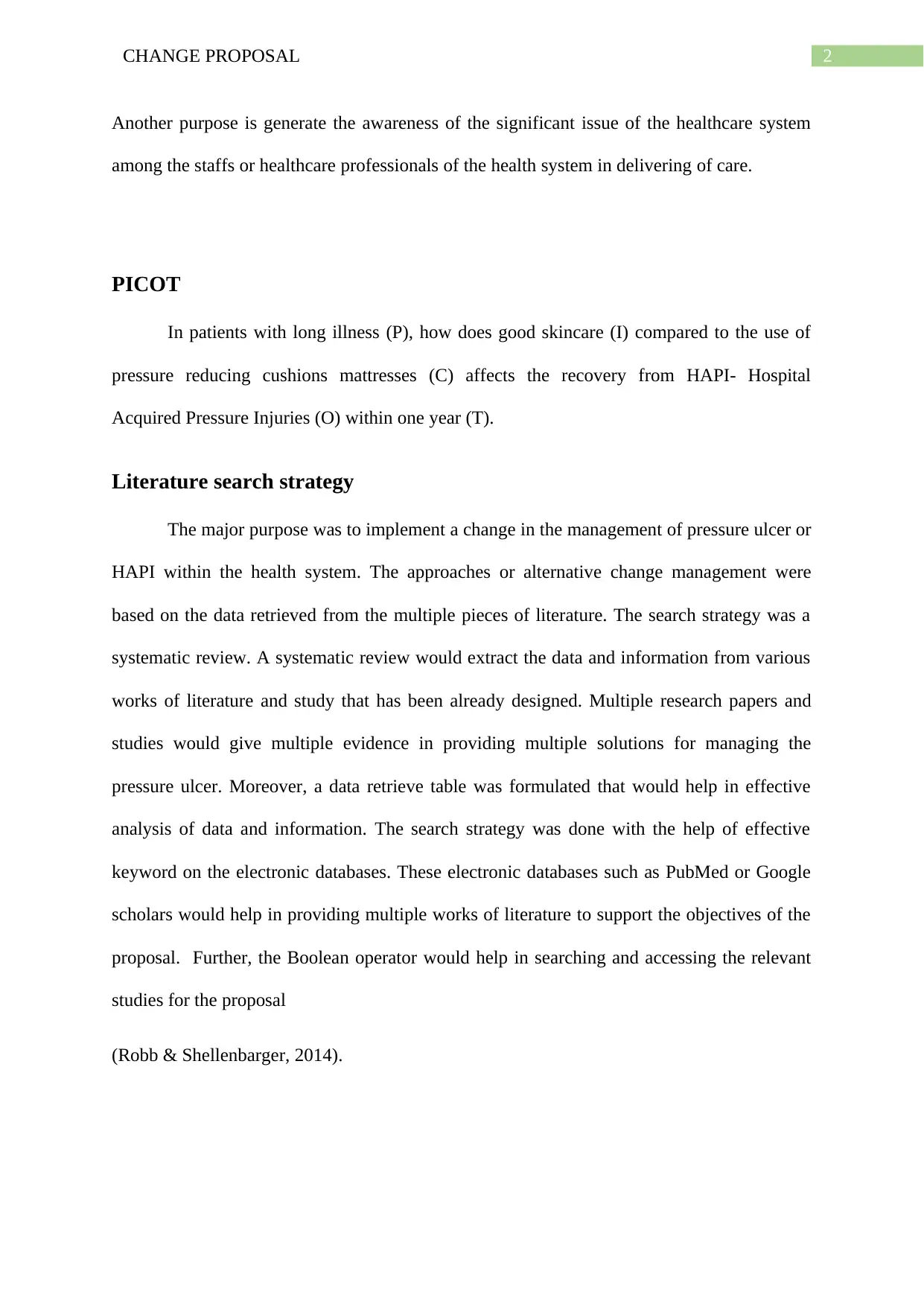
2CHANGE PROPOSAL
Another purpose is generate the awareness of the significant issue of the healthcare system
among the staffs or healthcare professionals of the health system in delivering of care.
PICOT
In patients with long illness (P), how does good skincare (I) compared to the use of
pressure reducing cushions mattresses (C) affects the recovery from HAPI- Hospital
Acquired Pressure Injuries (O) within one year (T).
Literature search strategy
The major purpose was to implement a change in the management of pressure ulcer or
HAPI within the health system. The approaches or alternative change management were
based on the data retrieved from the multiple pieces of literature. The search strategy was a
systematic review. A systematic review would extract the data and information from various
works of literature and study that has been already designed. Multiple research papers and
studies would give multiple evidence in providing multiple solutions for managing the
pressure ulcer. Moreover, a data retrieve table was formulated that would help in effective
analysis of data and information. The search strategy was done with the help of effective
keyword on the electronic databases. These electronic databases such as PubMed or Google
scholars would help in providing multiple works of literature to support the objectives of the
proposal. Further, the Boolean operator would help in searching and accessing the relevant
studies for the proposal
(Robb & Shellenbarger, 2014).
Another purpose is generate the awareness of the significant issue of the healthcare system
among the staffs or healthcare professionals of the health system in delivering of care.
PICOT
In patients with long illness (P), how does good skincare (I) compared to the use of
pressure reducing cushions mattresses (C) affects the recovery from HAPI- Hospital
Acquired Pressure Injuries (O) within one year (T).
Literature search strategy
The major purpose was to implement a change in the management of pressure ulcer or
HAPI within the health system. The approaches or alternative change management were
based on the data retrieved from the multiple pieces of literature. The search strategy was a
systematic review. A systematic review would extract the data and information from various
works of literature and study that has been already designed. Multiple research papers and
studies would give multiple evidence in providing multiple solutions for managing the
pressure ulcer. Moreover, a data retrieve table was formulated that would help in effective
analysis of data and information. The search strategy was done with the help of effective
keyword on the electronic databases. These electronic databases such as PubMed or Google
scholars would help in providing multiple works of literature to support the objectives of the
proposal. Further, the Boolean operator would help in searching and accessing the relevant
studies for the proposal
(Robb & Shellenbarger, 2014).
⊘ This is a preview!⊘
Do you want full access?
Subscribe today to unlock all pages.

Trusted by 1+ million students worldwide
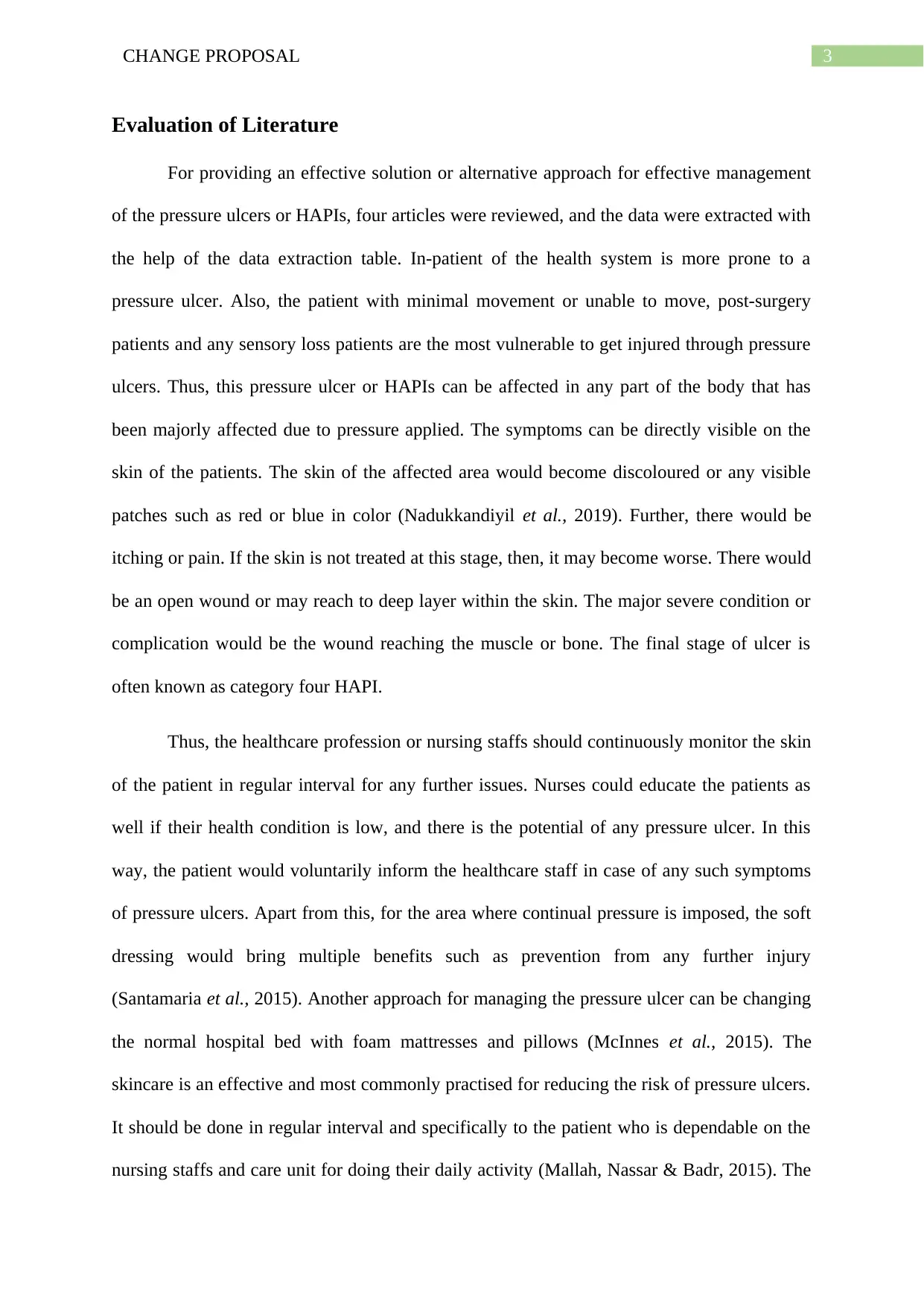
3CHANGE PROPOSAL
Evaluation of Literature
For providing an effective solution or alternative approach for effective management
of the pressure ulcers or HAPIs, four articles were reviewed, and the data were extracted with
the help of the data extraction table. In-patient of the health system is more prone to a
pressure ulcer. Also, the patient with minimal movement or unable to move, post-surgery
patients and any sensory loss patients are the most vulnerable to get injured through pressure
ulcers. Thus, this pressure ulcer or HAPIs can be affected in any part of the body that has
been majorly affected due to pressure applied. The symptoms can be directly visible on the
skin of the patients. The skin of the affected area would become discoloured or any visible
patches such as red or blue in color (Nadukkandiyil et al., 2019). Further, there would be
itching or pain. If the skin is not treated at this stage, then, it may become worse. There would
be an open wound or may reach to deep layer within the skin. The major severe condition or
complication would be the wound reaching the muscle or bone. The final stage of ulcer is
often known as category four HAPI.
Thus, the healthcare profession or nursing staffs should continuously monitor the skin
of the patient in regular interval for any further issues. Nurses could educate the patients as
well if their health condition is low, and there is the potential of any pressure ulcer. In this
way, the patient would voluntarily inform the healthcare staff in case of any such symptoms
of pressure ulcers. Apart from this, for the area where continual pressure is imposed, the soft
dressing would bring multiple benefits such as prevention from any further injury
(Santamaria et al., 2015). Another approach for managing the pressure ulcer can be changing
the normal hospital bed with foam mattresses and pillows (McInnes et al., 2015). The
skincare is an effective and most commonly practised for reducing the risk of pressure ulcers.
It should be done in regular interval and specifically to the patient who is dependable on the
nursing staffs and care unit for doing their daily activity (Mallah, Nassar & Badr, 2015). The
Evaluation of Literature
For providing an effective solution or alternative approach for effective management
of the pressure ulcers or HAPIs, four articles were reviewed, and the data were extracted with
the help of the data extraction table. In-patient of the health system is more prone to a
pressure ulcer. Also, the patient with minimal movement or unable to move, post-surgery
patients and any sensory loss patients are the most vulnerable to get injured through pressure
ulcers. Thus, this pressure ulcer or HAPIs can be affected in any part of the body that has
been majorly affected due to pressure applied. The symptoms can be directly visible on the
skin of the patients. The skin of the affected area would become discoloured or any visible
patches such as red or blue in color (Nadukkandiyil et al., 2019). Further, there would be
itching or pain. If the skin is not treated at this stage, then, it may become worse. There would
be an open wound or may reach to deep layer within the skin. The major severe condition or
complication would be the wound reaching the muscle or bone. The final stage of ulcer is
often known as category four HAPI.
Thus, the healthcare profession or nursing staffs should continuously monitor the skin
of the patient in regular interval for any further issues. Nurses could educate the patients as
well if their health condition is low, and there is the potential of any pressure ulcer. In this
way, the patient would voluntarily inform the healthcare staff in case of any such symptoms
of pressure ulcers. Apart from this, for the area where continual pressure is imposed, the soft
dressing would bring multiple benefits such as prevention from any further injury
(Santamaria et al., 2015). Another approach for managing the pressure ulcer can be changing
the normal hospital bed with foam mattresses and pillows (McInnes et al., 2015). The
skincare is an effective and most commonly practised for reducing the risk of pressure ulcers.
It should be done in regular interval and specifically to the patient who is dependable on the
nursing staffs and care unit for doing their daily activity (Mallah, Nassar & Badr, 2015). The
Paraphrase This Document
Need a fresh take? Get an instant paraphrase of this document with our AI Paraphraser
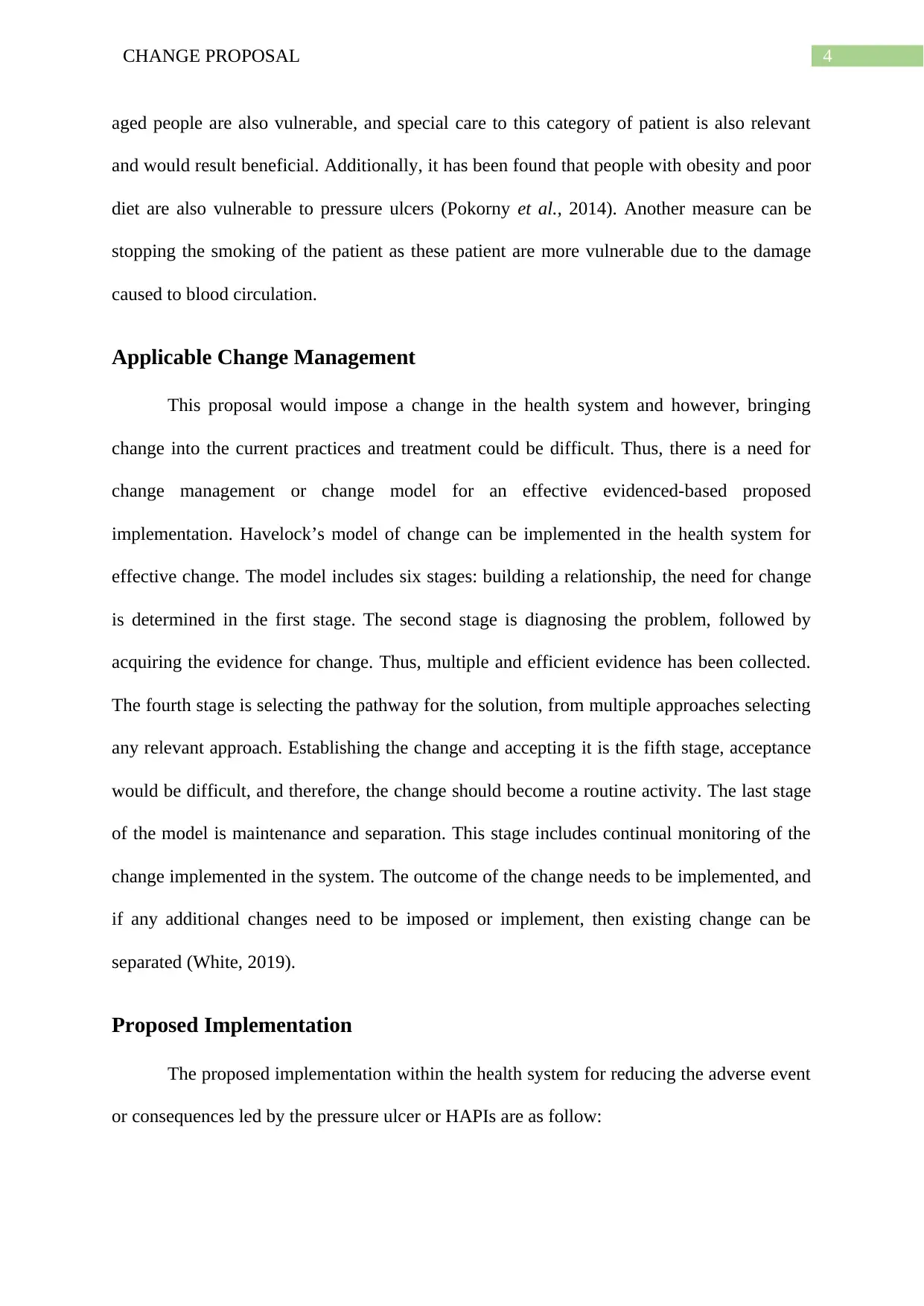
4CHANGE PROPOSAL
aged people are also vulnerable, and special care to this category of patient is also relevant
and would result beneficial. Additionally, it has been found that people with obesity and poor
diet are also vulnerable to pressure ulcers (Pokorny et al., 2014). Another measure can be
stopping the smoking of the patient as these patient are more vulnerable due to the damage
caused to blood circulation.
Applicable Change Management
This proposal would impose a change in the health system and however, bringing
change into the current practices and treatment could be difficult. Thus, there is a need for
change management or change model for an effective evidenced-based proposed
implementation. Havelock’s model of change can be implemented in the health system for
effective change. The model includes six stages: building a relationship, the need for change
is determined in the first stage. The second stage is diagnosing the problem, followed by
acquiring the evidence for change. Thus, multiple and efficient evidence has been collected.
The fourth stage is selecting the pathway for the solution, from multiple approaches selecting
any relevant approach. Establishing the change and accepting it is the fifth stage, acceptance
would be difficult, and therefore, the change should become a routine activity. The last stage
of the model is maintenance and separation. This stage includes continual monitoring of the
change implemented in the system. The outcome of the change needs to be implemented, and
if any additional changes need to be imposed or implement, then existing change can be
separated (White, 2019).
Proposed Implementation
The proposed implementation within the health system for reducing the adverse event
or consequences led by the pressure ulcer or HAPIs are as follow:
aged people are also vulnerable, and special care to this category of patient is also relevant
and would result beneficial. Additionally, it has been found that people with obesity and poor
diet are also vulnerable to pressure ulcers (Pokorny et al., 2014). Another measure can be
stopping the smoking of the patient as these patient are more vulnerable due to the damage
caused to blood circulation.
Applicable Change Management
This proposal would impose a change in the health system and however, bringing
change into the current practices and treatment could be difficult. Thus, there is a need for
change management or change model for an effective evidenced-based proposed
implementation. Havelock’s model of change can be implemented in the health system for
effective change. The model includes six stages: building a relationship, the need for change
is determined in the first stage. The second stage is diagnosing the problem, followed by
acquiring the evidence for change. Thus, multiple and efficient evidence has been collected.
The fourth stage is selecting the pathway for the solution, from multiple approaches selecting
any relevant approach. Establishing the change and accepting it is the fifth stage, acceptance
would be difficult, and therefore, the change should become a routine activity. The last stage
of the model is maintenance and separation. This stage includes continual monitoring of the
change implemented in the system. The outcome of the change needs to be implemented, and
if any additional changes need to be imposed or implement, then existing change can be
separated (White, 2019).
Proposed Implementation
The proposed implementation within the health system for reducing the adverse event
or consequences led by the pressure ulcer or HAPIs are as follow:
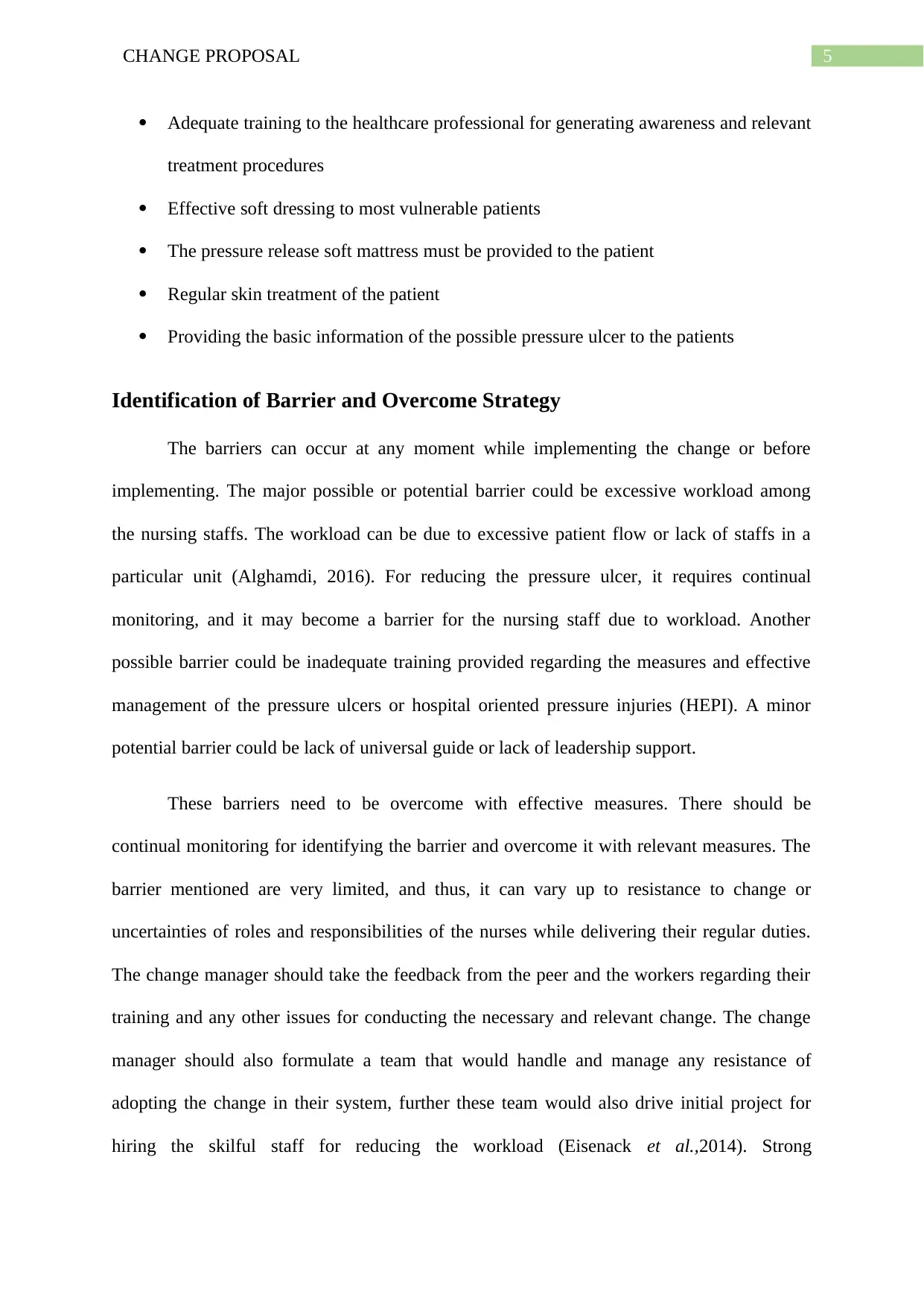
5CHANGE PROPOSAL
Adequate training to the healthcare professional for generating awareness and relevant
treatment procedures
Effective soft dressing to most vulnerable patients
The pressure release soft mattress must be provided to the patient
Regular skin treatment of the patient
Providing the basic information of the possible pressure ulcer to the patients
Identification of Barrier and Overcome Strategy
The barriers can occur at any moment while implementing the change or before
implementing. The major possible or potential barrier could be excessive workload among
the nursing staffs. The workload can be due to excessive patient flow or lack of staffs in a
particular unit (Alghamdi, 2016). For reducing the pressure ulcer, it requires continual
monitoring, and it may become a barrier for the nursing staff due to workload. Another
possible barrier could be inadequate training provided regarding the measures and effective
management of the pressure ulcers or hospital oriented pressure injuries (HEPI). A minor
potential barrier could be lack of universal guide or lack of leadership support.
These barriers need to be overcome with effective measures. There should be
continual monitoring for identifying the barrier and overcome it with relevant measures. The
barrier mentioned are very limited, and thus, it can vary up to resistance to change or
uncertainties of roles and responsibilities of the nurses while delivering their regular duties.
The change manager should take the feedback from the peer and the workers regarding their
training and any other issues for conducting the necessary and relevant change. The change
manager should also formulate a team that would handle and manage any resistance of
adopting the change in their system, further these team would also drive initial project for
hiring the skilful staff for reducing the workload (Eisenack et al.,2014). Strong
Adequate training to the healthcare professional for generating awareness and relevant
treatment procedures
Effective soft dressing to most vulnerable patients
The pressure release soft mattress must be provided to the patient
Regular skin treatment of the patient
Providing the basic information of the possible pressure ulcer to the patients
Identification of Barrier and Overcome Strategy
The barriers can occur at any moment while implementing the change or before
implementing. The major possible or potential barrier could be excessive workload among
the nursing staffs. The workload can be due to excessive patient flow or lack of staffs in a
particular unit (Alghamdi, 2016). For reducing the pressure ulcer, it requires continual
monitoring, and it may become a barrier for the nursing staff due to workload. Another
possible barrier could be inadequate training provided regarding the measures and effective
management of the pressure ulcers or hospital oriented pressure injuries (HEPI). A minor
potential barrier could be lack of universal guide or lack of leadership support.
These barriers need to be overcome with effective measures. There should be
continual monitoring for identifying the barrier and overcome it with relevant measures. The
barrier mentioned are very limited, and thus, it can vary up to resistance to change or
uncertainties of roles and responsibilities of the nurses while delivering their regular duties.
The change manager should take the feedback from the peer and the workers regarding their
training and any other issues for conducting the necessary and relevant change. The change
manager should also formulate a team that would handle and manage any resistance of
adopting the change in their system, further these team would also drive initial project for
hiring the skilful staff for reducing the workload (Eisenack et al.,2014). Strong
⊘ This is a preview!⊘
Do you want full access?
Subscribe today to unlock all pages.

Trusted by 1+ million students worldwide
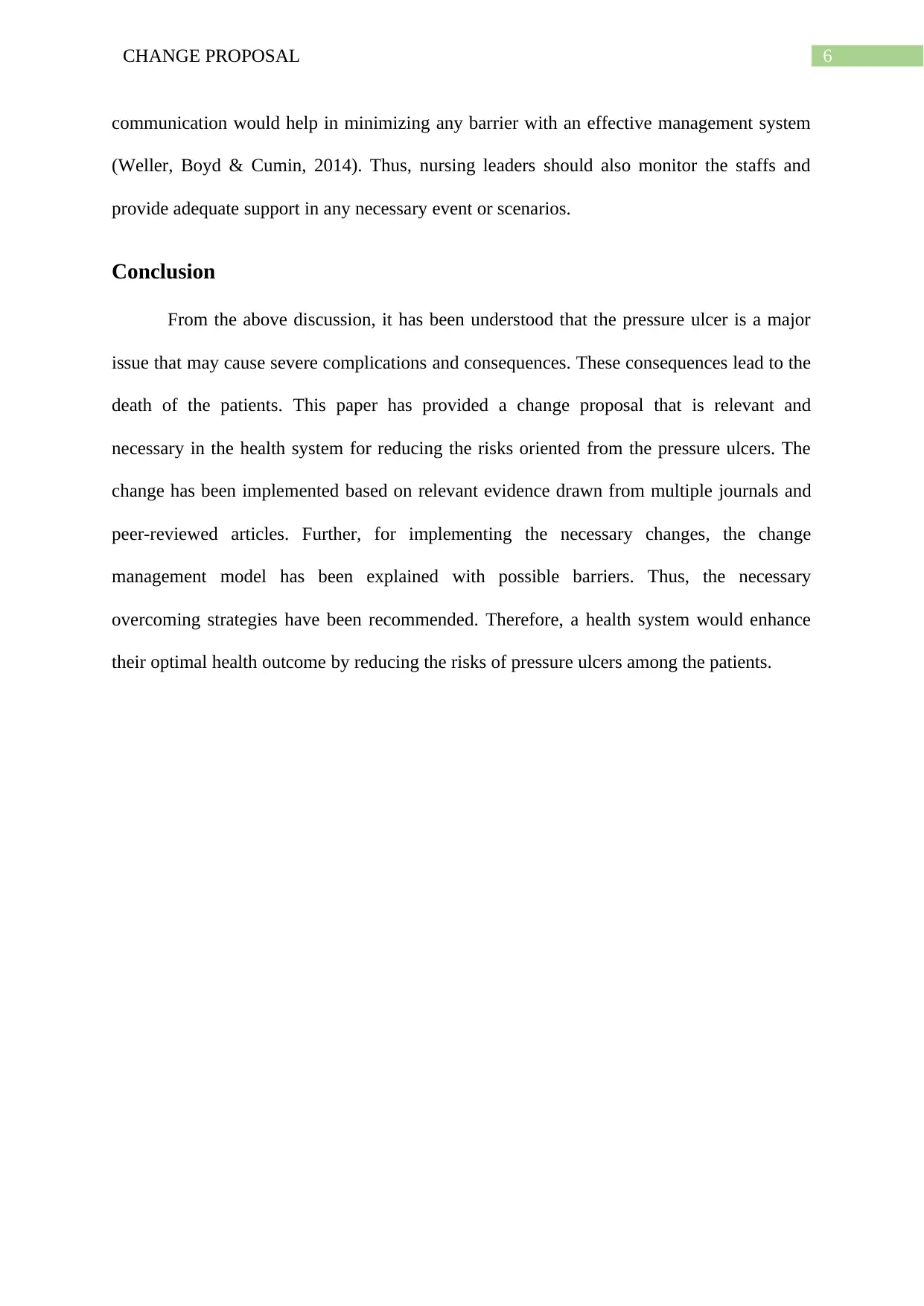
6CHANGE PROPOSAL
communication would help in minimizing any barrier with an effective management system
(Weller, Boyd & Cumin, 2014). Thus, nursing leaders should also monitor the staffs and
provide adequate support in any necessary event or scenarios.
Conclusion
From the above discussion, it has been understood that the pressure ulcer is a major
issue that may cause severe complications and consequences. These consequences lead to the
death of the patients. This paper has provided a change proposal that is relevant and
necessary in the health system for reducing the risks oriented from the pressure ulcers. The
change has been implemented based on relevant evidence drawn from multiple journals and
peer-reviewed articles. Further, for implementing the necessary changes, the change
management model has been explained with possible barriers. Thus, the necessary
overcoming strategies have been recommended. Therefore, a health system would enhance
their optimal health outcome by reducing the risks of pressure ulcers among the patients.
communication would help in minimizing any barrier with an effective management system
(Weller, Boyd & Cumin, 2014). Thus, nursing leaders should also monitor the staffs and
provide adequate support in any necessary event or scenarios.
Conclusion
From the above discussion, it has been understood that the pressure ulcer is a major
issue that may cause severe complications and consequences. These consequences lead to the
death of the patients. This paper has provided a change proposal that is relevant and
necessary in the health system for reducing the risks oriented from the pressure ulcers. The
change has been implemented based on relevant evidence drawn from multiple journals and
peer-reviewed articles. Further, for implementing the necessary changes, the change
management model has been explained with possible barriers. Thus, the necessary
overcoming strategies have been recommended. Therefore, a health system would enhance
their optimal health outcome by reducing the risks of pressure ulcers among the patients.
Paraphrase This Document
Need a fresh take? Get an instant paraphrase of this document with our AI Paraphraser
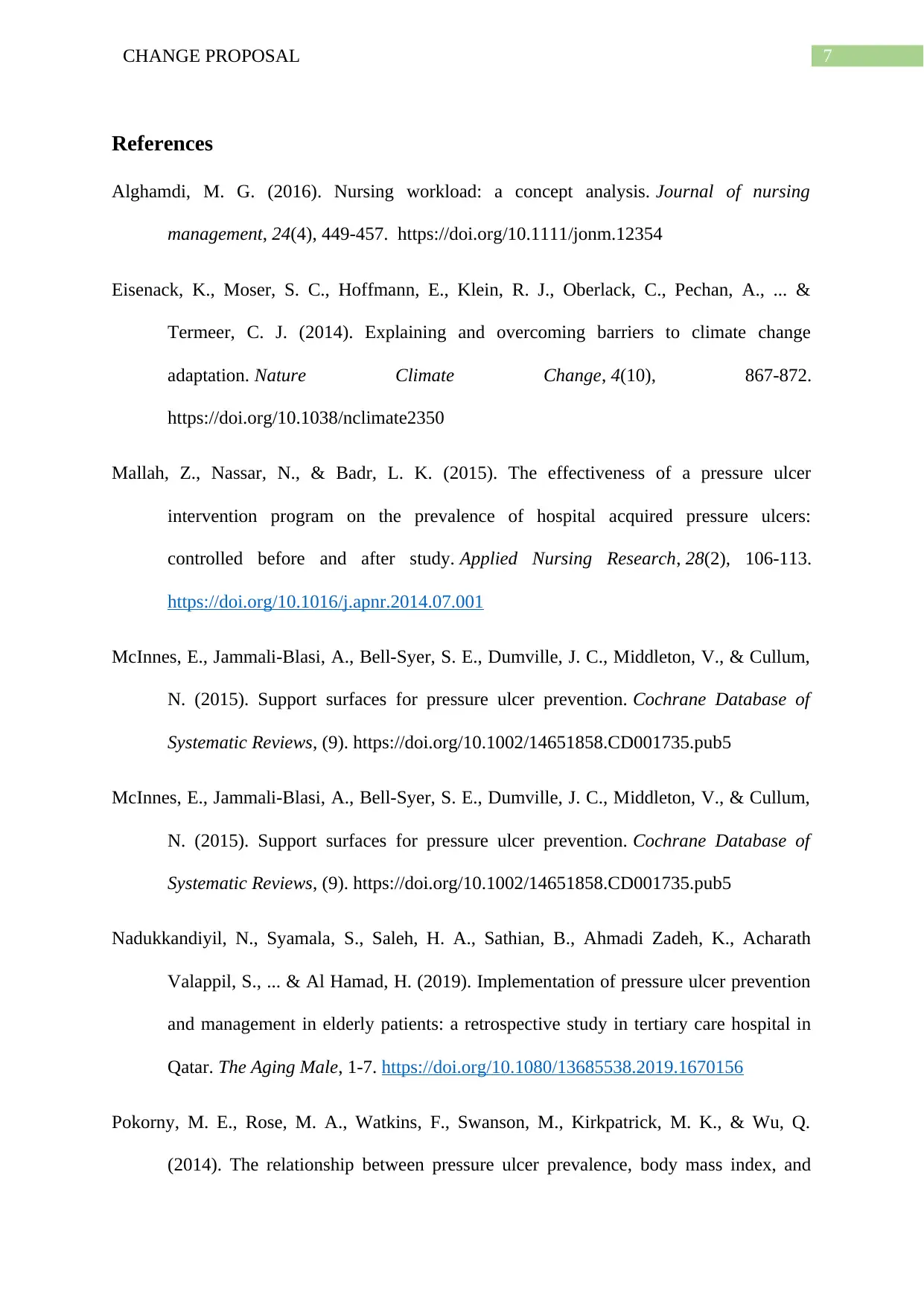
7CHANGE PROPOSAL
References
Alghamdi, M. G. (2016). Nursing workload: a concept analysis. Journal of nursing
management, 24(4), 449-457. https://doi.org/10.1111/jonm.12354
Eisenack, K., Moser, S. C., Hoffmann, E., Klein, R. J., Oberlack, C., Pechan, A., ... &
Termeer, C. J. (2014). Explaining and overcoming barriers to climate change
adaptation. Nature Climate Change, 4(10), 867-872.
https://doi.org/10.1038/nclimate2350
Mallah, Z., Nassar, N., & Badr, L. K. (2015). The effectiveness of a pressure ulcer
intervention program on the prevalence of hospital acquired pressure ulcers:
controlled before and after study. Applied Nursing Research, 28(2), 106-113.
https://doi.org/10.1016/j.apnr.2014.07.001
McInnes, E., Jammali‐Blasi, A., Bell‐Syer, S. E., Dumville, J. C., Middleton, V., & Cullum,
N. (2015). Support surfaces for pressure ulcer prevention. Cochrane Database of
Systematic Reviews, (9). https://doi.org/10.1002/14651858.CD001735.pub5
McInnes, E., Jammali‐Blasi, A., Bell‐Syer, S. E., Dumville, J. C., Middleton, V., & Cullum,
N. (2015). Support surfaces for pressure ulcer prevention. Cochrane Database of
Systematic Reviews, (9). https://doi.org/10.1002/14651858.CD001735.pub5
Nadukkandiyil, N., Syamala, S., Saleh, H. A., Sathian, B., Ahmadi Zadeh, K., Acharath
Valappil, S., ... & Al Hamad, H. (2019). Implementation of pressure ulcer prevention
and management in elderly patients: a retrospective study in tertiary care hospital in
Qatar. The Aging Male, 1-7. https://doi.org/10.1080/13685538.2019.1670156
Pokorny, M. E., Rose, M. A., Watkins, F., Swanson, M., Kirkpatrick, M. K., & Wu, Q.
(2014). The relationship between pressure ulcer prevalence, body mass index, and
References
Alghamdi, M. G. (2016). Nursing workload: a concept analysis. Journal of nursing
management, 24(4), 449-457. https://doi.org/10.1111/jonm.12354
Eisenack, K., Moser, S. C., Hoffmann, E., Klein, R. J., Oberlack, C., Pechan, A., ... &
Termeer, C. J. (2014). Explaining and overcoming barriers to climate change
adaptation. Nature Climate Change, 4(10), 867-872.
https://doi.org/10.1038/nclimate2350
Mallah, Z., Nassar, N., & Badr, L. K. (2015). The effectiveness of a pressure ulcer
intervention program on the prevalence of hospital acquired pressure ulcers:
controlled before and after study. Applied Nursing Research, 28(2), 106-113.
https://doi.org/10.1016/j.apnr.2014.07.001
McInnes, E., Jammali‐Blasi, A., Bell‐Syer, S. E., Dumville, J. C., Middleton, V., & Cullum,
N. (2015). Support surfaces for pressure ulcer prevention. Cochrane Database of
Systematic Reviews, (9). https://doi.org/10.1002/14651858.CD001735.pub5
McInnes, E., Jammali‐Blasi, A., Bell‐Syer, S. E., Dumville, J. C., Middleton, V., & Cullum,
N. (2015). Support surfaces for pressure ulcer prevention. Cochrane Database of
Systematic Reviews, (9). https://doi.org/10.1002/14651858.CD001735.pub5
Nadukkandiyil, N., Syamala, S., Saleh, H. A., Sathian, B., Ahmadi Zadeh, K., Acharath
Valappil, S., ... & Al Hamad, H. (2019). Implementation of pressure ulcer prevention
and management in elderly patients: a retrospective study in tertiary care hospital in
Qatar. The Aging Male, 1-7. https://doi.org/10.1080/13685538.2019.1670156
Pokorny, M. E., Rose, M. A., Watkins, F., Swanson, M., Kirkpatrick, M. K., & Wu, Q.
(2014). The relationship between pressure ulcer prevalence, body mass index, and
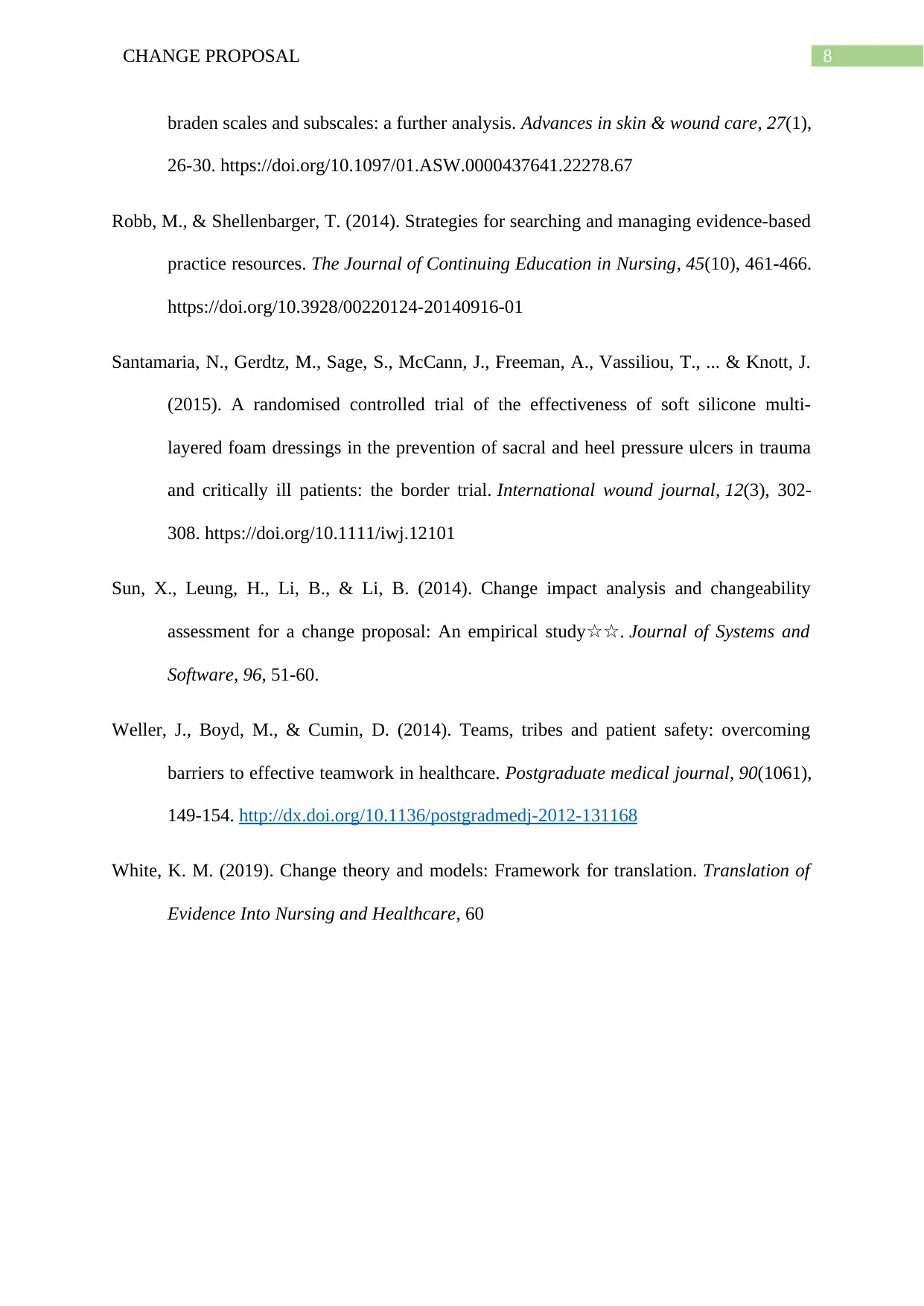
8CHANGE PROPOSAL
braden scales and subscales: a further analysis. Advances in skin & wound care, 27(1),
26-30. https://doi.org/10.1097/01.ASW.0000437641.22278.67
Robb, M., & Shellenbarger, T. (2014). Strategies for searching and managing evidence-based
practice resources. The Journal of Continuing Education in Nursing, 45(10), 461-466.
https://doi.org/10.3928/00220124-20140916-01
Santamaria, N., Gerdtz, M., Sage, S., McCann, J., Freeman, A., Vassiliou, T., ... & Knott, J.
(2015). A randomised controlled trial of the effectiveness of soft silicone multi‐
layered foam dressings in the prevention of sacral and heel pressure ulcers in trauma
and critically ill patients: the border trial. International wound journal, 12(3), 302-
308. https://doi.org/10.1111/iwj.12101
Sun, X., Leung, H., Li, B., & Li, B. (2014). Change impact analysis and changeability
assessment for a change proposal: An empirical study☆☆. Journal of Systems and
Software, 96, 51-60.
Weller, J., Boyd, M., & Cumin, D. (2014). Teams, tribes and patient safety: overcoming
barriers to effective teamwork in healthcare. Postgraduate medical journal, 90(1061),
149-154. http://dx.doi.org/10.1136/postgradmedj-2012-131168
White, K. M. (2019). Change theory and models: Framework for translation. Translation of
Evidence Into Nursing and Healthcare, 60
braden scales and subscales: a further analysis. Advances in skin & wound care, 27(1),
26-30. https://doi.org/10.1097/01.ASW.0000437641.22278.67
Robb, M., & Shellenbarger, T. (2014). Strategies for searching and managing evidence-based
practice resources. The Journal of Continuing Education in Nursing, 45(10), 461-466.
https://doi.org/10.3928/00220124-20140916-01
Santamaria, N., Gerdtz, M., Sage, S., McCann, J., Freeman, A., Vassiliou, T., ... & Knott, J.
(2015). A randomised controlled trial of the effectiveness of soft silicone multi‐
layered foam dressings in the prevention of sacral and heel pressure ulcers in trauma
and critically ill patients: the border trial. International wound journal, 12(3), 302-
308. https://doi.org/10.1111/iwj.12101
Sun, X., Leung, H., Li, B., & Li, B. (2014). Change impact analysis and changeability
assessment for a change proposal: An empirical study☆☆. Journal of Systems and
Software, 96, 51-60.
Weller, J., Boyd, M., & Cumin, D. (2014). Teams, tribes and patient safety: overcoming
barriers to effective teamwork in healthcare. Postgraduate medical journal, 90(1061),
149-154. http://dx.doi.org/10.1136/postgradmedj-2012-131168
White, K. M. (2019). Change theory and models: Framework for translation. Translation of
Evidence Into Nursing and Healthcare, 60
⊘ This is a preview!⊘
Do you want full access?
Subscribe today to unlock all pages.

Trusted by 1+ million students worldwide
1 out of 9
Related Documents
Your All-in-One AI-Powered Toolkit for Academic Success.
+13062052269
info@desklib.com
Available 24*7 on WhatsApp / Email
![[object Object]](/_next/static/media/star-bottom.7253800d.svg)
Unlock your academic potential
Copyright © 2020–2025 A2Z Services. All Rights Reserved. Developed and managed by ZUCOL.





